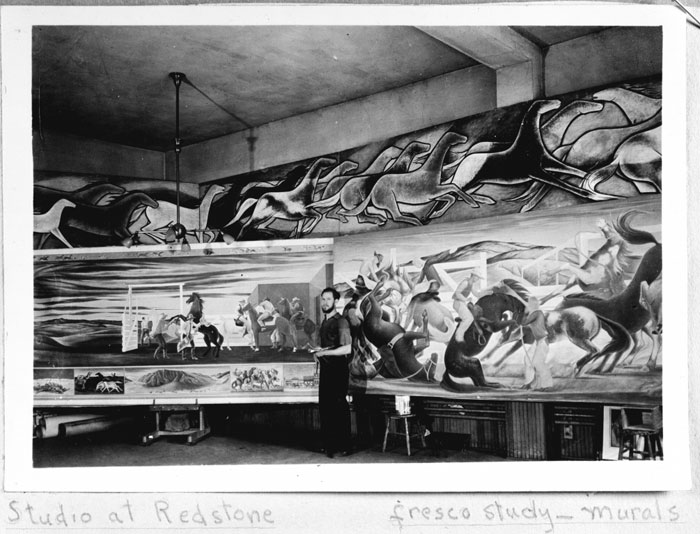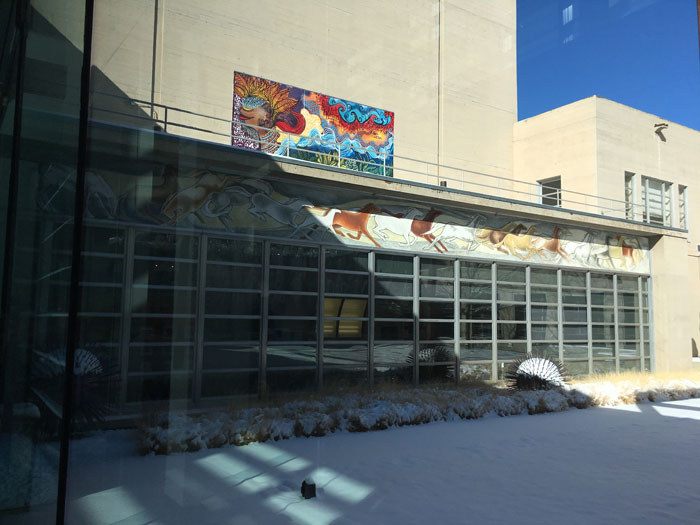In the Saddled/Ensillados section of Stampede: Animals in Art a string of multi-colored horses gallop, buck, and rear above other equine-related artworks. In 1936 artist Frank Mechau (pronounced “may-show”, 1904–1946) prepared this 60-foot-long study for a mural in the courtyard of the Colorado Springs Fine Arts Center. Uniting the diverse influences of his travels to artistic hubs of the early twentieth century–including Chicago, New York, Paris, Munich, and Florence–this work also reflects Mechau’s lifelong interest in the subjects of his native American West.
Raised near Glenwood Springs, Mechau studied at the University of Denver before moving to Chicago, where he studied at the School of the Art Institute of Chicago. He then moved to New York City, where he met and married Paula Ralska. In 1929 the couple moved to Paris, where they quickly became immersed in the city’s vibrant circles. There, Mechau exhibited his paintings to positive acclaim.
After traveling to Italy and Germany, the couple moved back to Denver in 1932. There, in the midst of the Great Depression, Mechau started teaching at the Kirkland School of Art and soon opened his own school. In 1934, Mechau won a prestigious Guggenheim award (the first of three), which, in his words, allowed him to “saturate my mind with the rich material of landscape, rodeos, horses with which this territory abounds, and retain in my mind subjects for paintings for years to come.”
Mechau established a studio in Redstone, Colorado and taught at the Broadmoor Academy (which became the Colorado Springs Fine Arts Center in 1936). Further afield, he taught at Columbia University in New York City and served as an artist correspondent for Life Magazine during World War II before returning to Colorado where, tragically, a heart attack ended his life.
Influences
During his years in Paris, Mechau purposefully avoided the influence of French impressionists and post-impressionists. In his own words, he was more interested in “Italian Primitives, Persian Miniatures, [and] Chinese and Japanese paintings and prints…” Mechau was particularly impressed by the frescoes of Piero della Francesca in Arezzo, Italy painted between 1452 and 1466. As a result of such influences, Mechau “dismissed forever mottled and hatched complementary colors and began to paint with broad areas of simple primary colors.”
Wild Horses demonstrates not only Mechau’s interest in traditional fresco techniques, but also his ability to render strong, bold areas of color—here the horses’ bodies—which he animates using sensitive gradations in shading and careful compositional flow. While the horses take a variety of poses, notice how a lighter wave of color passes behind and through their forms, as if they are pulled forward along the same ribbon of energy.
When planning this work, the final version of which is in the inner courtyard of the Colorado Springs Fine Arts Center, Mechau was restricted to a tight section of wall above a bank of windows. He thus turned to one of his most enduring subjects – the horse – and, while endowing each body with its own rearing, kicking, galloping personality, elegantly strung them together in a 60-foot-long undulation of power and exuberance.
Other Works
Wild Horses is part of the DAM's western American art collection. If you’re curious to see other works by Mechau on public display in Denver, visit:
- the newly reopened Kirkland Museum of Art to see his Abstraction from 1931
- the Denver Public Library to see Saturday P.M. from 1942 (which is on long-term loan from the DAM) and Horses at Night from 1934
- the second floor of the Byron Rodgers Federal Courthouse on 19th and Stout to see Wild Horse Race from 1936 and The Corral (aka Pony Express) from 1936



